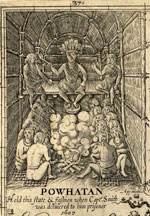Primary Source Sets on the Web
It can be time-consuming to find and prepare primary sources for your lessons. On each of the below sites, you will find primary sources that address multiple topics in U.S. History. Many of the sites provide sources that have been prepared for the classroom, from excerpting lengthy documents to providing clear headnotes and source information. Start at one of these sites to find primary sources to use in your next lesson!
Digital History Reader, from Virginia Tech University: These documents are organized into instructional modules, from 1492 to the Nixon administration. Each module contains selected primary documents, as well as a central investigative question and introduction to the topic, questions for individual documents and assignments.
EDSITEment, from the National Endowment for the Humanities: EDSITEment has roughly 400 lesson plans for the history/social studies classroom, sortable by grade-level and subtopic. Lesson activities are built around primary documents from various collections, including those of the Library of Congress.
Explorations, from Digital History: Explorations is divided into thematic units, organized chronologically from pre-Columbian America to the Vietnam War. Each unit has a teacher resources section containing a wealth of sources, including selected primary documents. Also check out the site’s Ethnic Voices section that also includes selected choice documents.
Historical Scene Investigation, from the Library of Congress and the Schools of Education at the College of William and Mary and the University of Kentucky: Thirteen sets of documents, organized by theme—from “Jamestown Starving Time” to “When Elvis Met Nixon—cover various periods in American history. Each thematic unit contains a number of primary documents, some of which are excerpted or adapted for easier classroom use. This site may be of particular interest to teachers of middle and elementary grades.
Historical Thinking Matters, a project of the Stanford University School of Education and the Center for History and New Media at George Mason University:This site includes documents on four topics—the Spanish American War, the Scopes Trial, Social Security, and Rosa Parks—and are prepared for use in the classroom. Accompanied by teacher materials and strategies, documents address the varied ways historians have interpreted these topics.
History Now, by the Gilder Lehrman Institute of American History: Each of these quarterly journals focus on a central theme and contain a set of K-12 lesson plans that use primary sources.
Primary Source Sets, from the Library of Congress: This collection, designed for teachers and accompanied by support materials, provides primary source sets for key topics and themes in American history, from Abraham Lincoln to Women’s Suffrage.
Reading Like a Historian Curriculum, from the Stanford History Education Group: This curriculum features lessons that revolve around central historical questions and feature sets of primary documents that have been modified for students with diverse skills and abilities. Spans U.S. history from Colonial times to the Cold War.
TeacherServe, from the National Humanities Center: This site brings together dozens of essays by leading historians around three themes—religion in U.S. history, the environment, and the African American experience. What makes TeacherServe unique is that primary source materials are embedded via hyperlinks in the essays themselves, providing context for understanding the documents in relation to the broader theme as well as in relation to each other.
You can also visit this entry for places to find online collections of primary sources.
